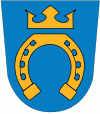Espoo
 |
Espoo was first settled in the Prehistoric Era, with the first signs of human settlements going back as far as 8,000 years, but the population effectively disappeared in the early stages of the Iron Age. In the Early Middle Ages, the area was resettled by Tavastians and Southwestern Finns. After the Northern Crusades, Swedish settlers started migrating to the coastal areas of present-day Finland, and Espoo was established as a self-governing Catholic parish in the 15th century. In the aftermath of the Finnish War, the establishment of Helsinki as the new capital of the Russian-controlled Grand Duchy of Finland in 1812 greatly benefited the development of the municipality. However, the area remained largely agrarian, until the 20th century. Espoo experienced rapid urbanization and major demographic changes in the decades following World War II, with Finnish superseding Swedish as the language of the majority around 1950. The municipality became a market town in 1963 and gained city status in 1972.
The cityscape is dominated by detached housing and suburban environment, and the city itself is known for its large natural areas, including its long shoreline—58 kilometres in total —and archipelago, forests, lakes and a national park. Administratively, the city is divided into seven major districts, and each major district is further divided into smaller districts and neighbourhoods. Espoo has no traditional city centre; instead, it has five distinct city centres—Leppävaara, Tapiola, Matinkylä, Espoon keskus and Espoonlahti—and numerous local centres, many of which are formed around historical manors.
Aalto University is based in Otaniemi, Espoo, along with a thriving science community that includes numerous startups and organizations such as VTT – the Technical Research Center of Finland. Several major companies are based in Espoo, including Nokia, HMD Global, Tieto, KONE, Neste, Fortum, Orion Corporation, Outokumpu, and Foreca, as well as video game developers Rovio and Remedy Entertainment. Espoo joined the UNESCO Global Network of Learning Cities in 2015.
Map - Espoo
Map
Country - Finland
 |
 |
| Flag of Finland | |
Finland was first inhabited around 9000 BC after the Last Glacial Period. The Stone Age introduced several different ceramic styles and cultures. The Bronze Age and Iron Age were characterized by contacts with other cultures in Fennoscandia and the Baltic region. From the late 13th century, Finland became a part of Sweden as a consequence of the Northern Crusades. In 1809, as a result of the Finnish War, Finland became part of the Russian Empire as the autonomous Grand Duchy of Finland, during which Finnish art flourished and the idea of independence began to take hold. In 1906, Finland became the first European state to grant universal suffrage, and the first in the world to give all adult citizens the right to run for public office. After the 1917 Russian Revolution, Finland declared independence from Russia. In 1918, the fledgling state was divided by the Finnish Civil War. During World War II, Finland fought the Soviet Union in the Winter War and the Continuation War, and Nazi Germany in the Lapland War. It subsequently lost parts of its territory, but maintained its independence.
Currency / Language
| ISO | Currency | Symbol | Significant figures |
|---|---|---|---|
| EUR | Euro | € | 2 |
| ISO | Language |
|---|---|
| FI | Finnish language |
| SV | Swedish language |















